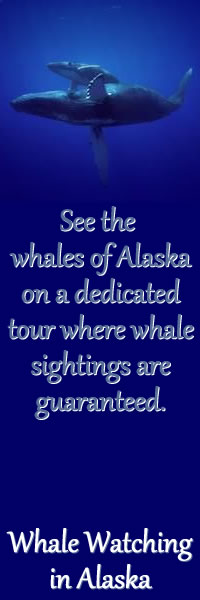 |
Alaska whale watching tours allow the visitors an opportunity to observe and photograph Humpback, Orca, Gray, and Beluga whales, along with many other marine mammals, in their natural environment. |
 |
|
Captains Choice Whale-Watching-Alaska.com |
 |
 |
|
 |
|
Humpback Whales of Alaska.Alaska Whale Watching Tours, Humpback Whale Identification. The humpback whale got its name due to the fact that the dorsal fin sits on a big hump on the whales back which is visible when the whale arches its back and dives. Humpback whales can be found in the Bering Sea, Aleutian Islands, Prince William Sound, Glacier Bay and throughout the Inside Passage of South East Alaska in the summer. In the winter they move south to the Banderas Bay in Mexico, Baja California and the Hawaiian islands. They spend the spring, summer and fall months in the cooler waters around Alaska and head for warmer waters in the winter months. Researchers believe that there may be resident populations in the southeastern part of the state. Their diet consists of krill and many different kinds of fish including chovies, sardines, herring and capelin. They gather their food by blowing a net of bubbles to surround and confuse their prey, then with jaws open swim through the center of the air ring to scoop up their food. Baleen, finger like material, hangs down in the whale’s mouth to filter the food from the water. They eat one to one and a half tons of food a day. During winter months they don’t feed but live off fat reserves in their blubber. They are easily identified by the distinct hump in front of their dorsal fin. They have the largest scalloped, winglike flippers of any whale species. They are mostly black with a white area on their throat. The flippers are all white beneath and partly white above. They are unusually susceptible to parasites resulting in there being up to a half a ton of barnacles on a single whale. Humpbacks can be found in groups of four to five but generally travel and feed individually. They are relatively slow swimmers with speeds up to 16 miles per hour with and average speed of 2-9 miles per hour. In the summer they dive for 3-5 minutes but in the winter breeding grounds can dive for 15-30 minutes. Humpback whales breech, throwing themselves completely out of the water. You may also see them swimming on their back with both flippers in the air. They are known for tail lobbing, raising its huge fluke out of the water and slapping it on the water surface. Researchers believe this is a form of communication as the slaps can be heard for long distances underwater. Humpback whales have the most diverse range of sounds for any whale or animal in the world. Sounds include moans, shrieks and grunts. Males sing for 10-20 minutes to attract a mate, repeating the sequence for hours during winter breeding months. Their feeding song is high-pitched which stuns fish causing them to stop swimming long enough for the humpback to gobble them up. The humpback whales main predator is the killer whale. Commercial whalers were allowed to hunt humpbacks into the 20th century. Today as whales live so close to the coastlines they are often hurt by pollution, collision with boats and getting tangled in fishing nets. But this is why new rules have been created to protect the mammals of our oceans. You will find that tour boats must maintain a safe viewing distance to protect the whales. Many times the passengers would like to get close to the whales; however the captain has the safety of the ship and whale in mind. This is not to say that a whale may not surface close to the side of the boat. Humpback WhaleThe orca or killer whale is readily identified. With it's pointed dorsal fin of up to 6 feet tall and shinny black and white white bodies typically sporting a white patch behind the eyes. Common names: Humpback Whales
Humpback Whales in Alaska.Prince William Sound: approximately 100 whales. Whale Watching Alaska | Whale Watching | Whales in Alaska | Whale Watching Tours | Killer Whales Here on Whale Watching Alaska you will find information on Alaska whale populations, distributions and over all health. Promotes environmentally responsible whale watching trips featuring gray whale, killer whale, humpback whale, beluga and whale pod photo. Numbers obtained from the Alaska Dept. of Fish and Game and Noah. |
